Between UX Content Office Hours, my LinkedIn network, the Content Career Accelerator, and my UX writing newsletter (shameless plugs, all of them!), a lot of people ask me where to look for jobs in UX content. Because I love a challenge, and hate forgetting things, I decided to organize what tips I’ve collected so far into this very guide. And, because this community is rad, I also got a lot of great suggestions on LinkedIn!
Good news and bad news
If you’re looking for a job as a UX writer, content designer, or content strategist, I have some good news and some bad news.
The good news is that there are quite a few places to look. The bad news is that there are quite a few places to look!
The various content-flavored UX specializations — content strategy, content design, content operations, UX writing, and information architecture, to name the biggest ones — are still quite niche relative to classic business functions like accounting or project management. And they’re still more niche than common UX roles like design or research. Further complicating things is the fact that many organizations don’t have a complete understanding of the true value of these UX content roles, nor do they always quite know where or how to find the right person for the job.
Given all that, your search for a UX content job may not resemble any of your prior job searches. Especially if you are trying to transition from a professional background outside of product and UX. You’ll need to look and read more carefully, search more deeply and creatively, and, in some cases, work quite a bit harder than you might have to work for another kind of job.
I don’t say any of that to intimidate you nor scare you off. I just want you to be in the right mindset. There are a lot of good people out there who want to help you navigate this field, and lots of resources to help you prepare for and find the job that you want. You can do this; it just might not play out the way you expect.
An important note before we begin: Please don’t go directly from hearing about UX writing or content design to immediately trying to find a job with those specific words in the job title. Getting fixated on the job title is the path to misery. The next step in getting into this field may or may not be a job with those words in the title. Full-time positions with “content designer” or “UX writer” in the job title are still few and far between, even at large tech companies that have plenty of people with those skills on staff. Many senior practitioners, myself included, have walked a long and winding road to get where they are, and many of the jobs on their resumes don’t have the word content in them at all. For the best chance of success, read each job description carefully, be creative with your keyword searches, and keep an open mind.
In addition to looking for open positions to apply for, please keep doing research on how people get into the jobs that they have, and the paths and backgrounds of people working in UX content. You’ll thank me later.
Caveats: Over. Let’s go!
Communities
The broader UX content community (especially the content strategy community) is incredibly generous and open. People want to help! People want to share! The more people doing this work, the merrier, we say.
Finding and joining a professional community, big or small, official or independent, can be a great way to learn about new opportunities and get the inside scoop. Let’s explore some of the more popular options.
Content + UX
Content + UX is a fantastic and long-running Slack team originally started by my friend Michael Metts, and now masterfully moderated by Jess Sand and company. This is the place most recommended by fellow UX content enthusiasts on LinkedIn, if that tells you anything.
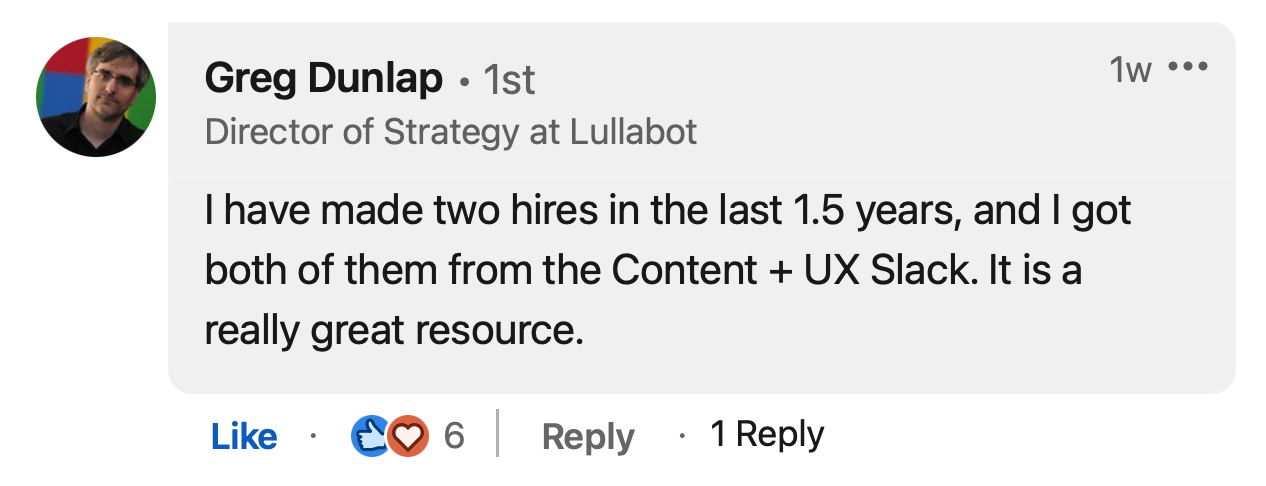
It’s a very large community, so you get some startup hustlers and similar nonsense. But the moderating team does an overall fantastic job keeping things clean and useful — especially the job board.

You have to apply to join Content and UX, and it might take the volunteer team a few weeks to process your application. Once you’re in, the channel to look for is #career-job-openings-and-gigs. It’s one of my favorite places to look for jobs because community rules require that the salary range be included with any job posting. Keep in mind that many U.S.-based positions are only willing to disclose a salary range because it’s required by a state or local law, so you’ll often see a range that’s specific to the area with the law (such as Colorado or New York), and that the actual salary range might be higher or lower based on where you live. (Also note that not every company adjusts compensation by location, but many do.)
While you’re there, you might also check out the #career-development-and-growth channel to learn from others on the search.
It doesn’t cost anything to join this community, nor to list open positions. This means you might be more likely to find higher ed, non-profit, government, and small startup positions that might not have the budget for costlier job boards.
Tip: After joining, spend a few weeks listening and observing. Like any good online community, there are both norms and policies. If you want to put your best foot forward, make sure you know where to step. Do not immediately post a 1,000-word sob story about your job search, or an advertisement for your freelance services, in some random channel. I’m sympathetic, but it’s not a good look.
Professional societies and industry-specific organizations
Content strategy and content design jobs exist at all kinds of companies. It may well be that a professional group that you’re already connected to (or could be connected to) is a great place to find a lead on your next role.
Just because your current employer doesn’t understand content design and won’t make room for you doesn’t mean that’s true for every employer in your industry! Lean on those existing connections, or consider joining a group that connects with your background or education. Tech is not the only industry hiring UX content people! I’ll say it again: Tech is not the only industry hiring UX content people! Look further. Go farther.
I found my second job in UX content via a job board for the now-defunct Information Architecture Institute. No, that’s not immediately helpful for you. But the general idea of finding job boards and postings through professional group and societies still holds.
I’m not only talking about UX or content-related societies like UXPA and STC, which are both good places to look. I’m also talking about professional societies and associations for any discipline you can think of, in any field that you might have a connection with or interest in.
Local and regional meetup groups
Not everyone is lucky enough to live somewhere with a meetup community dedicated to content or UX. If you do, my goodness, join! Attend! Volunteer! Get involved! Meetups of like-minded professionals can be springboards for your career. It’s connections, knowledge, and opportunities all rolled into one.
 group on LinkedIn.](https://kubie.co/wp-content/uploads/2022/07/MarioCDE.png)
The Meetup.com website is one way to find them, yes, but not every meetup is on Meetup — see UX Content Design NYC or Sydney Content Strategy, for example. You may want to do a bit of searching before you decide that your city doesn’t have a meetup. The UX Writing Library has a good list, for starters.
And hey, if you don’t have one? Start one! It worked for me, anyway.
Tip: If there’s not a UX-specific meetup in your area, try something adjacent. Think about the kinds of people who might work at companies hiring for UX content — startups, coders and developers, marketing professionals — and consider networking in groups of interest to those folks.
Other communities to explore
- Content Strategy Community – I’m not a member so I don’t know what all goes on in here, but my impression is that all-around good egg Hilary Marsh started it after getting fed up with all the spam and nonsense in the big LinkedIn content strategy group. Worth a look, especially if content strategy is of particular interest to you!
- Bootcamp/accelerator cohorts and communities – If you’re contemplating a bootcamp or accelerator, give some consideration to their reputation, including their network of alumni and educators.
Job boards
You might get lucky, of course, and find a relevant UX content job listed on general-interest job sites like Indeed and ZipRecruiter. But many folks report that the big general boards often have positions that aren’t really about content design or UX content or content strategy at all, despite the job titles. Often, they are more traditional digital marketing roles, or just something else entirely, that happen to be keyword-stuffed with UX terminology.
So you might have better luck, or at least be able to study more relevant job descriptions more quickly, by using one of these design industry specific job boards.
Working in Content
Working in Content is a for-profit job board started by some folks affiliated with Gather Content, a headless-CMS and workflow tool beloved by many in the content strategy community.
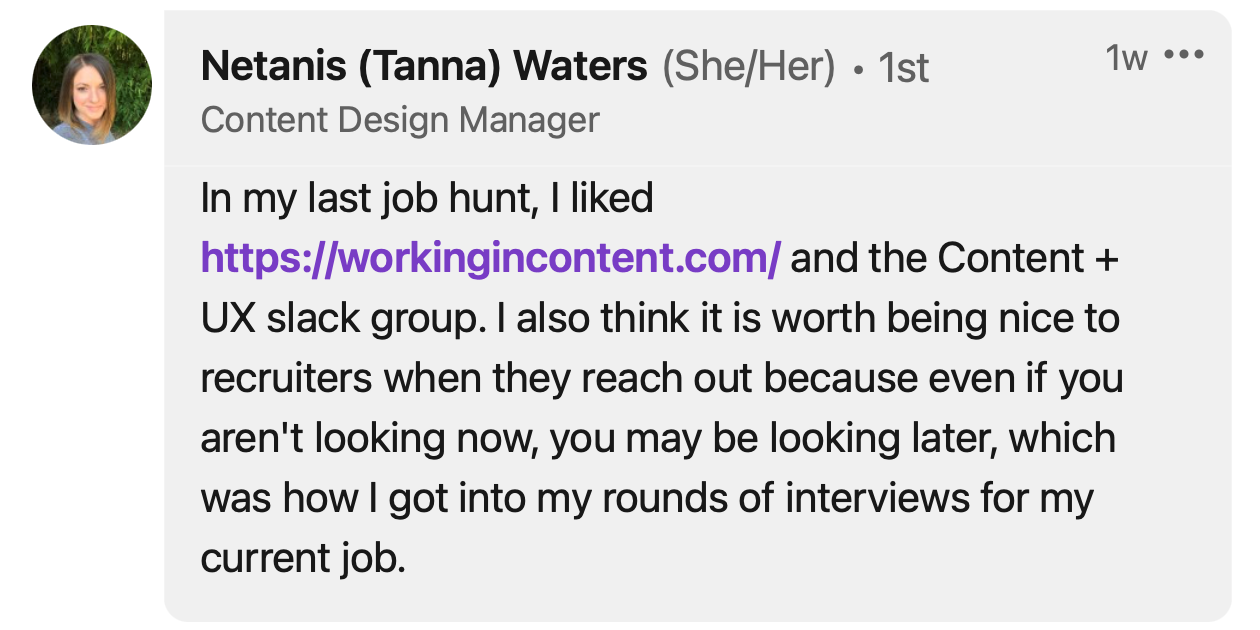
It costs a few hundred bucks to publish a job there, so if nothing else, you can be confident that the position very likely exists and is not just a honeypot for collecting email addresses (you’d be surprised).
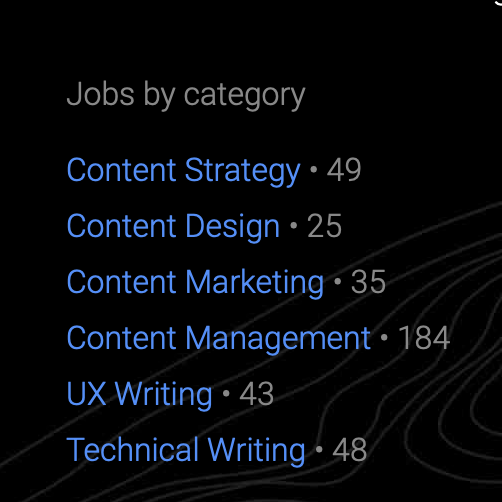
Some content job titles on the Working in Content homepage as of this writing included Senior Website Content Strategist, Learning Content Designer, Content Marketing Manager, Content Specialist, UX Writer, and Lead Technical Writer. Nice!
While you’re on the site, be sure to click on their mysteriously-named Resources tab (spoiler: it’s a blog) for tips and career-focused interviews with UX content professionals.
UX Content Collective
The UX Content Collective (a sharp rebrand from their former identity as the UX Writer’s Collective) primarily offers workshops and training for current and aspiring UX content professionals.
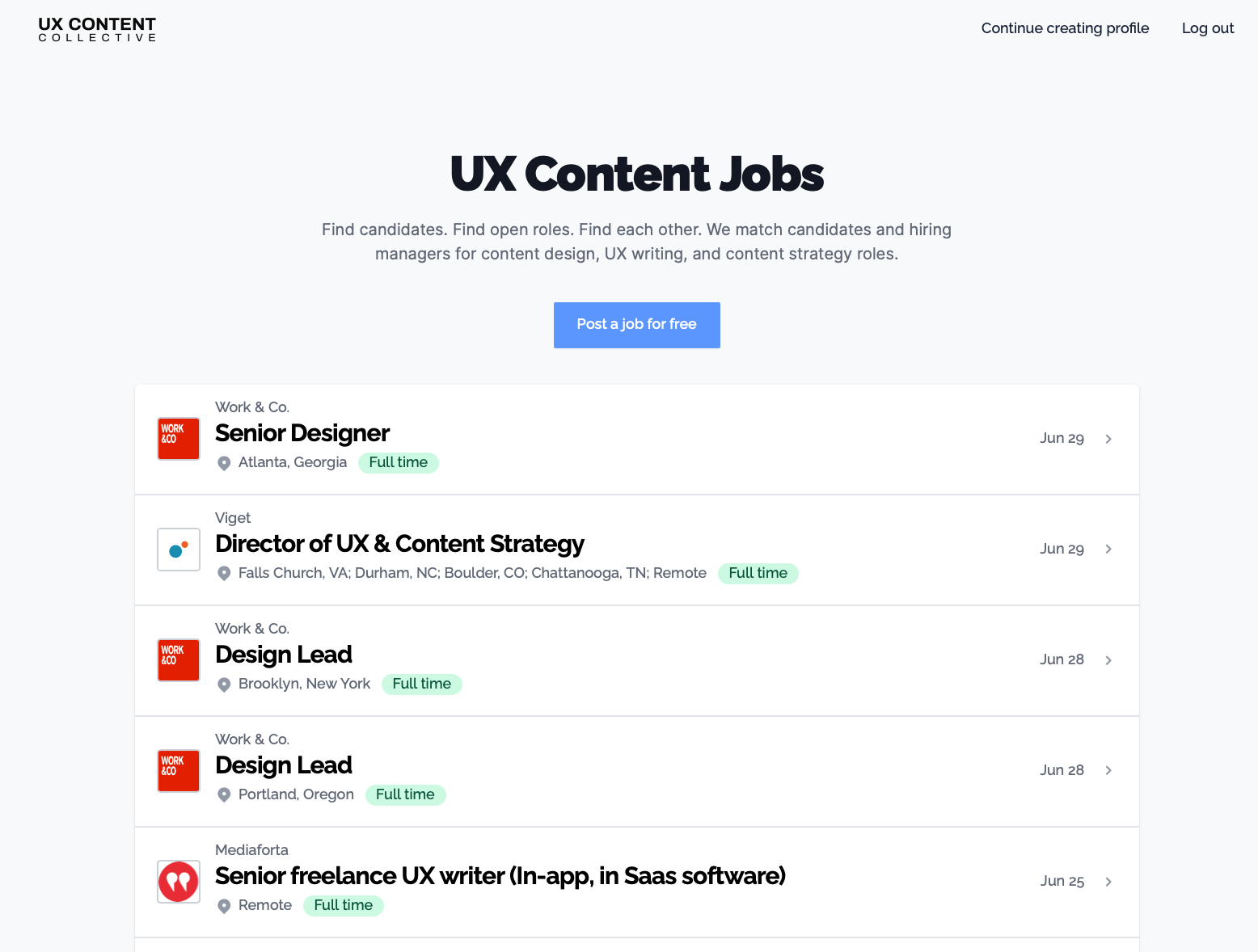
They have their own job board, which includes a matchmaking-style feature based on the profile you create as a job seeker when registering. My impression is that they are experimenting with whether to make this totally-free or packaged up with their training offerings, but for the moment, at least, you can view all of the currently-posted roles if you know where to look (hint: it’s right there, at that link).
Jobs listed as of this writing included Manager, Content Design at Mastercard and Principal UX Content Strategist at Nordstrom. Good stuff!
Now, the job board is fine and all, but the really good stuff is in the jobs newsletter. Navigate to their newsletters page and subscribe to the UX Content jobs newsletter by Gordon Macrae. If you want some great writing, additional insights, and delightful color commentary with your job listings, Gordon’s newsletter is where it’s at. (The Dash is pretty good too, while you’re at it.)
Boooom
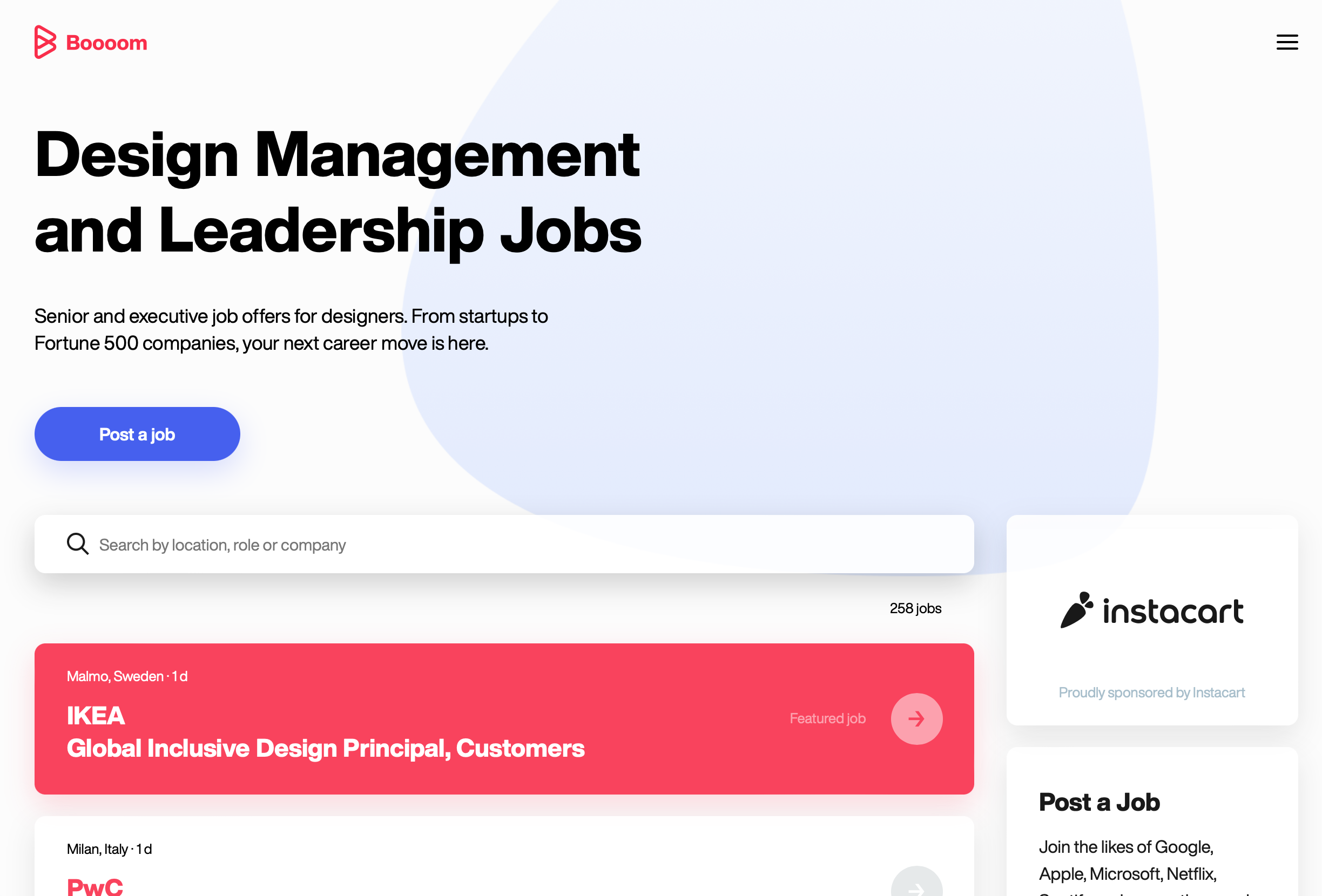
I personally checked the Boooom job board daily when I thought what I wanted was to get a job like Director of Content Design. It’s tidy, it’s pretty, it updates often enough considering that these kinds of roles don’t open every day, and they more-or-less exclusively list management and leadership-level design positions (yes, including content).
It can feel a bit like a game of Whac-A-Mole, as each post links directly to a job listing, except sometimes that listing is gone, or it goes to a generic careers page, or the role has a generic description on the board like “Design Manager” but the specific title is something like “Visual Design Manager”. Still, still. It’s highly-scannable and worth adding to your list if you’re eyeing that management/leadership track. I have seen content leadership jobs here at companies like Mailchimp, Instacart, and more.
Other misc. job boards
I don’t know much about these, but they turned up in my research, and might be worth a look depending on your needs:
- Content Writing Jobs (UX Writing category) — They cast an awfully wide net on this board, including lots of copywriting and marketing writing jobs, so you might want to stick with the UX writing category.
- Microcopim community job board – Kinneret Yifrah, author of Microcopy: The Complete Guide, pointed me to this board for jobs in Israel.
- Content Science Review job board — Not much activity but you never know!
- UIE Job Board – As a brand, UIE has more of a research and usability focus, but when organizing this article, I saw several content design related roles on the board. If someone knows to post to UIE, their organization probably has at least half an idea of how UX should actually be practiced, so that’s a plus.
- Otta – I did a few tests and found some UX writing and content design jobs I hadn’t recently seen elsewhere. The interface itself is pretty slick, too. Worth a look!
- Early Stage Design Jobs – I went through the first 125 roles listed on this board focused on entry-level and junior design roles. Only one was for content design, and, upon inspection, the actual role was more of a marketing/graphic design position. But! There were some UX research and product design internships and apprenticeships listed. Those skills would absolutely be excellent starting points for a career in UX content.
D.I.Y. (self-directed searches)
In ye olden days, before the web, this section might have been headlined “legwork”. But before the web no one was hiring UX writers, so … I’m not really sure where I’m going with this.
Anyway, I guess I wanted to say that you can still find jobs by looking for them. I don’t mean searching for them by typing ‘UX writer jobs’ into Google, I mean looking, damn it. Using your brain! If you’re serious about your career, consider doing more than setting up some saved searches on big job boards. Get curious, put on your thinking cap, and do some sleuthing. Here are a few ideas to get you started.
Top employers in your area
Every company with content — which is every company — needs content strategy. Every company with apps, applets, websites, software, and services needs content design. That’s also every company.
So, while the job titles might not be what you think you’re looking for, I assure you, the work is out there. You’ve just got to dig a little deeper into the job descriptions, and, if you can, meet and network with people in the organization to learn about their needs.
In many regions, top employers tend to be large organizations such as universities, hospital systems, insurers, banks and financial services companies, and similar. Those types of organizations are almost always hiring for some kind of content role.
Consider, for instance, that most of them have large footprints of internal content, such as an employee intranet or knowledge base, that requires whole teams of content designers, producers, information architects, and more.
Many of these organizations might not have UX teams, or if they do, the UX function is small and focused on, say, the primary corporate marketing website. That means that job titles, career ladders, etc., might not match what you think you’ve learned so far about UX content jobs. So keep an open mind.
If you’re thinking about relocating, you’ll find that there’s often that one company you’d have never guessed that has its headquarters where you’re headed. On a recent drive, I was gobsmacked to see a massive WWE flag (yes, the wrestling people) flying over an otherwise nondescript office building in Stamford, Connecticut! As of this writing, they’re hiring for a marketing director, digital campaign manager, and community relations manager. Give me a hell yeah!
The careers page of any tech company you can think of
At the biggest companies, finding candidates (that’s you!) is a full-time job for many, many people. They do not want to make it difficult for you to find open roles. Quite the opposite.
So, head over to Great Big Tech Company dot com, send your scroll wheel spinning, and stop down at the footer of their home page. Look for a phrase like ‘Careers’ or ‘Work with us’ or ‘Join our team’.
This is a good place to start if you’re new to the job search, even if you don’t want to work in big tech (good for you!) because you’ll get a feel for some of the commonalities in how these roles are described, and often find lots of free things to read about skills and qualities they’re looking for in candidates.
My personal experience is that a company’s own job listings will often not be the first place that new roles get posted, but it’s generally the most accurate listing of positions that have not fully, formally been filled. It’s often faster for hiring managers to post new roles on, for instance, LinkedIn or a third-party’s job board. But those listings also often expire without anyone bothering to remove them. So, pros and cons. Your mileage may vary.
Social media accounts of UX content managers and directors
It’s a great day for a team when that headcount request comes through and they can finally start recruiting! Many managers and design team leaders will use their own social media profiles, especially LinkedIn and Twitter, to post about their open roles.
Importantly, I’m recommending here that you follow the actual managers and directors; the people at the places that you want to work who are running the teams. People like me, doing their own thing or running a consultancy or whatever, might hear about and boost jobs from time to time, but tend not to be as reliable of a source.
“But Scott”, you say, “how do I find these UX content leaders?”
Glad you asked! I’m sure some LinkedIn sleuthing could get you there, but my favorite source is the next item in our list: events!
Content design and content strategy events
Find who’s speaking at content strategy and content design conferences, and who’s speaking about content at UX and product conferences, and follow them. Those folks, quite often, are either very senior individual contributors, practice leaders, or managers at their respective companies. They also tend to be a good follow anyway as you’re trying to learn more about this field. Great events to investigate include Confab, Button, and Design & Content. You’ll also often see these folks popping up at events like Perspectives and various panels and meetups about jobs in UX content.
If you have the time and/or budget to actually attend some of these events, so much the better. I regularly see folks post in the chat of online meetups about new roles that have opened on their teams. Imagine the great first impression you’ll make having attended the same presentation as the hiring manager! And something to talk about, too! Aces.
And of course, there’s the good-old-fashioned networking that can happen at events and conferences. I’d say this is even more the case now with online and hybrid events, as if someone is hiring, they can just post that in the online discussion board for the conference rather than hoping they’ll bump into the right person.
Oh, and if I may, my newsletter UX Writing Events is a great way to find these events. Just saying.
Sure, yes, fine, also LinkedIn
You can absolutely find UX content jobs on LinkedIn. It’s how most people find these jobs, according to what people on Twitter tell me.
But also? It’s how most people find these jobs. Think about that for a minute. Anything as popular as LinkedIn (or similar sites that list hundreds of thousands of jobs for every possible industry and profession) is going to have drawbacks. You’re going to find a lot of “content strategy” jobs that are actually marketing jobs. You’re going to think you’ve found 10 jobs to apply for, but you’ve actually found 1 job listed 10 times by 10 different recruiters — and oops, it’s already been filled, sorry about that! If you apply through their tools, without talking to anyone or building any connections or having an inside scoop, you might be one of literally hundreds of one-click applicants for the same role. I tell ya, friend, I don’t like those odds.
Me, I’m somebody who will just walk out of the bar and find another if there’s a line to get a drink. Crowded pools, long lines, packed clubs … it’s just not for me. And it’s never really been how I’ve approached my job search, either.
So look on LinkedIn, yes. But I probably didn’t need to tell you that. Me, I tend to lean on LinkedIn (and similarly massive job boards) as a sort of meta-discovery tool. They’re a good way to find out about companies that you didn’t even know existed, or to see, broadly, what kinds of job titles folks are using these days for the work you want to do. And your actual LinkedIn network can be a fantastic way to see, in general, which companies are hiring right now (and which are doing the opposite). If you learn that someone is hiring product designers and researchers, hey, it’s worth asking if they have any content roles.
My advice is to use LinkedIn as an extension of your real-world networking, and to do all the things you would do in a job search if the internet never existed, but on LinkedIn — make genuine connections, show interest in the work other people are doing, demonstrate value, ask questions, contribute usefully to the conversation, etc. If you’re only ever clicking on that “Jobs” tab, popping in a search, and auto-applying to 50 roles, don’t be surprised if you don’t get much in return.
(Speaking of behaving on LinkedIn like it’s the real world, maybe don’t interrupt someone’s conversation to ask if they’ve got any job openings. Especially in the comments sections of things that I have personally posted? Thanks in advance.)
Recruiters (even the “clueless” ones)
Let’s get this out of the way: Some recruiters are basically salespeople who buy lists of candidates from who-knows-where and email you at three addresses while calling all three phone numbers they found for you, don’t listen to you at all, and play dumb when you ask about the salary range. Those particular people suck, and I hope they fall through the next time they use a portable toilet.
But that’s not all recruiters! It’s not even most of them. So. If you set your LinkedIn to “Open for Work” or otherwise signal your openness to a job, you’re going to hear from recruiters, the good ones (most of them) and the bad ones. The good ones can be your inside scoop on positions that haven’t yet hit a company’s careers page or the public job boards. You’ll want to have given some thought to precisely what you’re looking for to be able to navigate these conversations successfully. A very good question to practice is “What’s the salary range?”. It’s annoying if they won’t tell you, and sometimes a bad sign, but that’s just how the game is played at some places, unfortunately.
The advice you’ll get from most folks, including me, is to be polite, specific, and firm. Thank them for their interest, tell them the truth about what you’re looking for, and don’t feel like you owe them anything. Personally, I won’t take any general phone calls to “talk about what I’m looking for”, because I’m not actively searching for a new role and also I already know what I’m looking for and can copy and paste it into a reply to their request for a phone call. But if you’re on the hunt, and get a good vibe from someone, a 15-minute phone call might at least be educational.
It’s helpful to have a specific answer you go to when recruiters reach out. For instance, lately I’ve been telling them something like this: “Thanks for reaching out! I’m focused on coaching and training content teams right now, if that’s a service your client is interested in. Not actively looking for a full-time role or contract, but always happy to hear about director or executive-level content/design leadership roles with base comp of $200k or higher. If you see any roles like that in the future, feel free to ping me again!” (To which they say “Oh yeah, content leadership is something they’re kinda sorta thinking about maybe looking at in two years, probably.” 
Keep in mind, too, that there are different kinds of recruiters. An in-house recruiter who works at the company you want to work for is definitely worth talking to. A recruiter at a big firm that hires people directly to their agency and then fills contracts with big companies might not be worth your time if that isn’t the kind of relationship you’re looking for. You may have to take a few conversations with different folks as you get oriented.
Where else?
Let’s expand this list! If I’ve missed something, please do write in and share so that we can help more people find the role that works for them. You can also help by adding suggestions to or sharing this LinkedIn post.
Further Reading
I happen to write quite a bit about navigating careers in UX content. Most of that writing eventually makes its way to this site, but some still lives on LinkedIn and elsewhere. Here are a few pieces you might enjoy:
- Tips on navigating promotions/raises as a junior UX writer (LinkedIn)
- Landing your first content design job panel discussion
- Two attributes that shape every content role
- Cuddle the muddle: paths into UX content
- You don’t have to be a native speaker to excel as a UX writer
- Content strategy is not just one thing
- Design jobs and design roles are not the same thing
- Scott Kubie’s UX Content FAQs